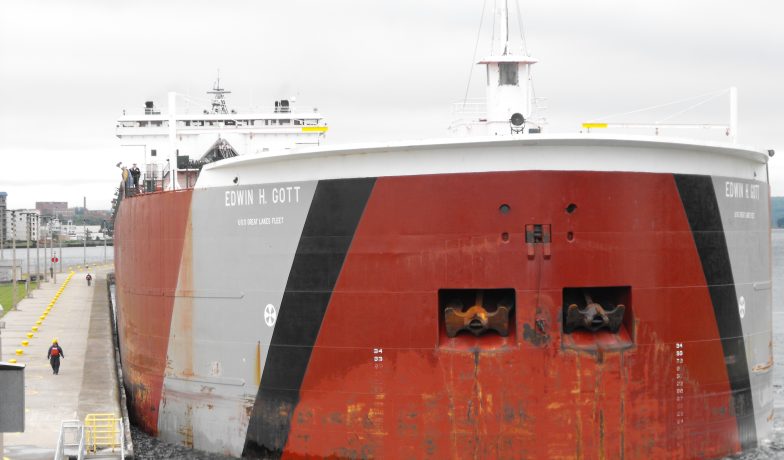Legacy of the Soo: The Remarkable Story of the Lock that Almost Wasn’t
Davis was correct that the 1984 amendment was the first step of many, but, in retrospect, he was not correct that it would be the toughest. Indeed, some of the most difficult challenges were ahead.
Construction Continues
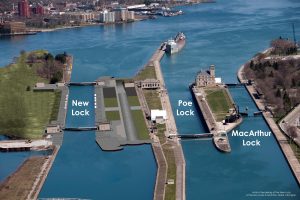
This June, more than four decades after that amendment, the U.S. Army Corps of Engineers (USACE) announced the contract awards for the third and final phase of construction of the New Lock at the Soo. “…[T]he Project continues to be on track for completion in 2030,” said the Corps’ Detroit District Senior Civilian Kevin McDaniels.
The new Soo Lock is remarkable for reasons far beyond its long gestation process. It is one of the largest public infrastructure projects ever on the Great Lakes and perhaps the largest project in the region ever fully (or nearly fully) funded by the U.S. federal government. At the end of the day, the price tag of the new Soo Lock is expected to total more than $3 billion. To give that number a point of reference, the five-mile-long Mackinac Bridge cost $70 million in 1958 or about $775 million in today’s dollars.
The importance of a smoothly functioning Soo Lock system is well known to the Great Lakes shipping community. Far less well known are the details of the tortuous path taken to fund the new lock first authorized by Congress four decades ago. Early decisions by the Corps of Engineers nearly sunk the project, and at times it appeared that the new Soo Lock was truly dead. At one point, more than two decades passed with virtually no progress. Only the herculean efforts of a bipartisan group of Congressional legislators and staff, key federal officials, a determined governor, a president and a cast of private sector stakeholders saved the project.
Today, the Corps has reversed itself and is not only on board but is a true champion of the project. In its June press release, the Corps described the new Soo Lock as “essential to U.S. manufacturing and national security.” The new lock is heading toward completion in great part because of the full commitment of the Corps.
But it wasn’t always that way. The following are 10 pivotal events on the road to the new Soo Lock.
- The original authorization (1986)
The 1984 amendment did not immediately lead to the authorization of the new lock, but it did help launch the process. In 1985, the Corps recommended the construction of a new, large lock at Sault Ste. Marie, Michigan, and the new lock was eventually authorized by Congress in 1986. The estimated price then was $227 million. Ultimately it would take more than $3 billion to finish the job.
Supporters cheered the authorization in 1986. But there was precious little to cheer about over the next two decades as the project nearly ground to a halt.
- The flawed benefit-cost analysis (2005)
In 2005, an analysis by Corps of Engineers economists assigned a benefit-cost ratio (BCR) to the new Soo Lock project of less than 1.0, rendering the project “not economically justifiable.” Over the next two decades, that BCR essentially froze the Soo Lock in place because the USACE rarely advanced a project with a BCR below 1.0. The BCR was criticized so regularly over the next several decades by supporters of the lock that it developed a built-in adjective: “the flawed BCR.” Critics particularly criticized assumptions by the Corps about the potential for the use of rail and other surface transportation to replace shipping if the current lock structure failed. The Corps had assumed there was an alternative rail route around the Soo because most river locks have rail routes that run parallel to the river,
Despite relentless Congressional and other pressure and evidence of obvious error, the Corps would refuse to budge from the 2005 BCR for the next 13 years, preventing any meaningful progress.
- Full federal funding (2007)
One of the biggest early obstacles to the new Soo Lock’s construction was the standard requirement that the federal government would pay 75% of the cost of the project, and states would be required to pay the remaining 25%, the so-called “local share.” Securing funding for the local share is often a challenge on large federal projects.
But the new Soo Lock project faced an additional hurdle – the question of how to divide that local share among the eight Great Lakes states. The new Lock was to be built in Michigan, but its benefits touched the entire Great Lakes, some states more than others. That issue alone paralyzed the project for many years as efforts to settle on a cost-sharing division among the states were unsuccessful.
The problem was solved in 2007 by Rep. James Oberstar (R-Minnesota), the chairman of the House Transportation and Infrastructure Committee, who led the effort to enact legislation making the new Soo Lock a 100% federally funded project. The veteran lawmaker emphasized that the new Lock had a national benefit, not just an eight-state benefit. The 100% federal funding legislation would prove to be one of the most important milestones. Division of the local cost share was controversial in the late 1990s and early 2000s when the local share was relatively small. It would have been even more controversial today as the price tag has dramatically increased.
- The ground-breaking – 16 years ago (2009)
One fact illustrates the long and winding road to the new Soo Lock: that the ground-breaking for the project took place in 2009. “We take a great deal of satisfaction in seeing actual construction start on the project,” said Illinois Gov. Pat Quinn, one of many who commented publicly at the time. In fact, nearly a decade would pass after those ceremonial shovels entered the ground that day in Sault Ste. Marie before any meaningful construction would take place on the new lock.
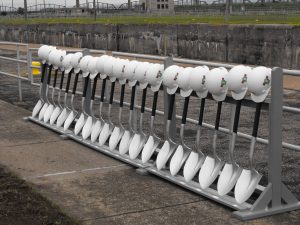
- Sen. Carl Levin meets with Army Corps Brig. Gen. Margaret Burcham (2013)
In 2013, Sen. Carl Levin (D-Michigan), then the chairman of the Senate Armed Services Committee, traveled to the Soo to meet with Brig. Gen. Margaret Burchum, then commander of the Corps’ Great Lakes and Ohio River Division. Chairman Levin pressed Burchum hard on the need to re-evaluate the BCR. The senator’s arguments seemed to land with the Corps commander, at least one attendee at the meeting said later.
One year later, the Corps of Engineers announced that it had completed a partial analysis to determine if a reassessment of the BCR might yield different results. As result, the Corps said it had decided to re-evaluate the BCR. The result of that study would not be known for four years.
- The study that changed everything (2015)
There was no single event that broke the longstanding logjam on the new Soo Lock, but one event with a significant impact was the release of a report by a relatively unknown government office called the Office of Cyber and Infrastructure Analysis (OCIA) at the U.S. Department of Homeland Security (DHS). The report, titled “The Perils of Efficiency: An Analysis of An Unexpected Closure of the Poe Lock and Its Impact,” (October 2015), would dramatically change the new Soo Lock debate.
The “Perils of Efficiency” analysis, authored by Dr. Craig S. Gordon, called the current Soo Lock the “Achilles heel of the North American industrial economy” and predicted that a closure would have “devastating” impact on the economy, leading to a “severe recession” because of the interruption of the steel supply chain. This report by a government author made the case for a new lock in Sault Ste. Marie to ensure much-needed transportation resiliency in a way that nothing had before.
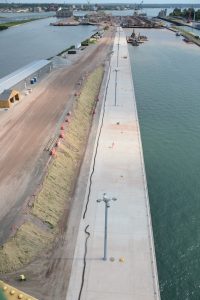
The Corps of Engineers, still relying on its controversial BCR analysis, found itself on the defensive as Soo Lock stakeholders pressed the agency to include consideration of the DHS OCIA report’s findings in the new BCR.
- The limo ride and the President Trump call out (April 2018)
The famous limo ride by President Donald J. Trump on April 28, 2018, has achieved nearly mystical status in the story of the new Soo Lock. The president was in Michigan for a campaign rally in Washington Township. He flew into Selfridge Air National Guard base and invited three Michigan U.S. House members—Rep. Jack Bergman, Rep. John Moolenaar and Rep. Paul Mitchell—to join him. The president asked his Republican colleagues if there were any important topics he needed to address.
The representatives suggested that the president talk about the new Soo Lock. The group quickly briefed the president on the project. Shortly afterward, during a lengthy campaign speech, Trump raised the topic of the Soo Lock, the first time a sitting president had ever publicly addressed it. “The Soo Locks are going to hell,” he told the crowd. “You know that, right? And we’re going to get them fixed up.” The crowd cheered. To more cheers, Trump vowed to personally assist, promising to contact the Corps “as soon as I get back. … Can I call on a Sunday?”
Whether he did or did not is unknown, But what is known is that because of these comments from the president himself, and perhaps due to an accumulation of other reasons, the new Soo Lock project suddenly had momentum. Lots of it.
- The Grand Hotel press conference (May 2018)
Shortly after the president’s announcement, which was headline news in the state, Michigan Gov. Rick Synder (R) added to the momentum. In a press conference on the porch of the Grand Hotel on Mackinac Island, Snyder, surrounded by other legislators and industry leaders, announced that the state of Michigan would contribute $52 million from its 2019 budget to help fund the new lock. At the time it was the single largest sum of money offered up for the new lock and the first funding of its kind from any state for this project.
“It’s time to build a lock,” Snyder said. “Michigan is stepping up now to say we’re going to put our money where our mouth is.” Shortly after his press conference that day, a group of Michigan members of Congress traveled to Sault Ste. Marie to see the lock area first-hand and to signal their commitment to moving forward with funding for the new lock project.
- The revised BCR (July 2018)
Pressure was building on the Corps of Engineers to construct the new lock. Nearly constant pressure by the Great Lakes congressional delegation, the Trump call-out, the Michigan money, the DHS study and other factors had dramatically ratcheted up pressure on the Corps to produce a BCR that more realistically accounted for the project’s benefits. The old BCR was now the main impediment to new Soo Lock construction.
In addition to the public pressure, a behind-the-scenes campaign by James “Jim” Weakley, the president of the Lake Carriers’ Association, was reaching its peak. Weakley had been involved in virtually every part of the campaign to build the new lock. The original BCR was set in 2005, shortly after Weakley took over as president of LCA. For more than a decade, Weakley had been a thorn in the side of the Corps as he pressed the agency to reconsider the analysis that he called “deeply flawed.” For more than a decade, his efforts had borne little fruit. However, at a meeting at Corps of Engineers headquarters in December 2016, he finally sensed progress, maybe even a breakthrough, as the agency admitted that some assumptions and projections used in the 2005 economic analysis were not currently accurate. His instincts proved true. In July 2018, the Corps announced that its Soo Lock Economic Validation Study had resulted in a revised BCR of 2.42, high enough to cross the threshold for obtaining federal funding for a new construction project. That decision was also aided by a stakeholder meeting organized by the agency in 2016 that addressed some of the flawed assumptions in the original BCR. “Now that we have completed the economic validation study, we look forward to the next steps to get a new lock built at the Soo,” said Lt. Col. Dennis Sugrue, the Detroit Engineer District’s engineer. The final hurdle had been crossed.

- The Corps of Engineers comes on board
On Nov. 23, 2018, the Corps of Engineers announced the Soo Lock as a new start in its FY ’19 work plan with $32 million in federal funding. Monies began to flow as the Corps began requesting funding on a regular basis, securing hundreds of millions of dollars from Congress, hiring contractors for the massive construction process and barreling toward completion. Freed from the original BCR, the agency is now executing the new lock construction project.
The lock that was almost never built has become a reality, but there was nothing simple about the journey. Weakley is fond of saying that “Life ain’t easy for a lock named Soo,” offering up his own humorous variation on singer Johnny Cash’s hit song about a boy who ultimately prevails after a life filled with challenges.
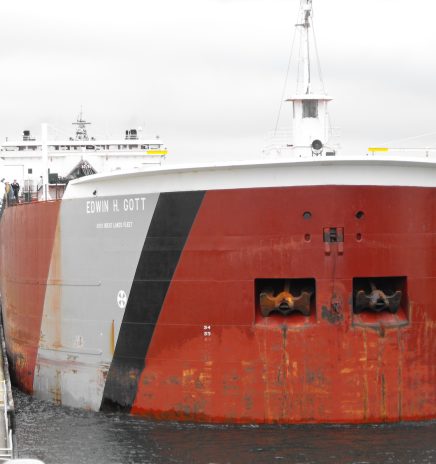
Legacy of the Soo: The Remarkable Story of the Lock that Almost Wasn’t
On June 29, 1984, then-U.S. Reps. Don Albosta (D-Michigan) and Bob Davis (R-Michigan) successfully offered a floor amendment in the U.S. House of Representatives, beginning the legislative process that would... Read More
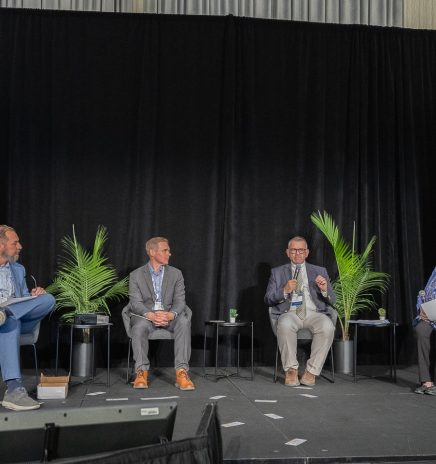
Industry Stakeholders Gather for the AGLPA 2025 Conference
Photos by Victor Studio – Chicago, Illinois The annual American Great Lakes Ports Association (AGLPA) Conference took place August 14 and 15. Industry stakeholders and leaders met for the two-day... Read More

